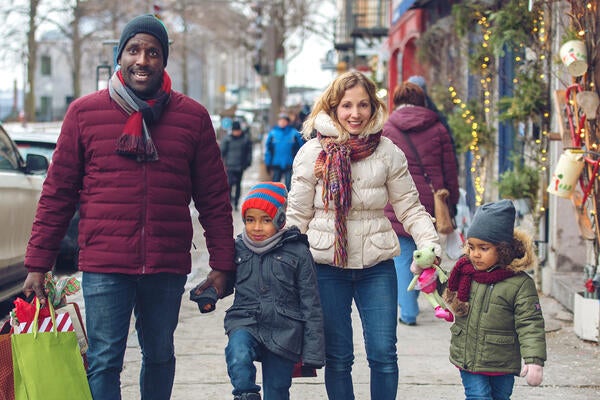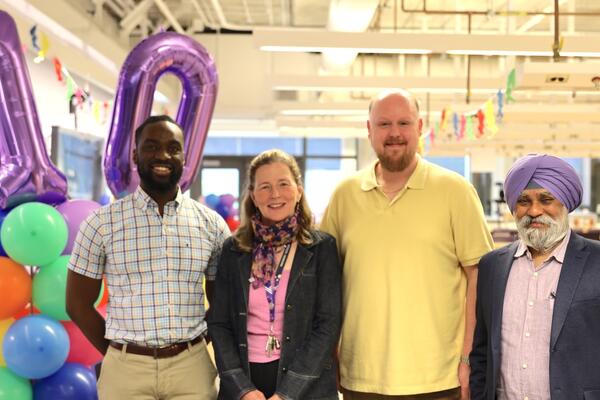
Thinking outside the box
Waterloo engineering technician creates a PPE-free enclosure for health workers administering COVID-19 swab tests

Waterloo engineering technician creates a PPE-free enclosure for health workers administering COVID-19 swab tests
By Brian Caldwell Faculty of EngineeringRobert Wagner ran into a problem while building a see-through booth so healthcare workers can test people for COVID-19 without using gowns, masks and other scarce personal protective equipment (PPE).
But it wasn’t a problem for long.
When all he could scrounge up for his contraption were two left-handed gloves, the longtime engineering technician at the University of Waterloo simply turned one of them inside out and carried on.
The solution was typical of Wagner’s approach to designing and building a testing booth to help medical professionals during the coronavirus pandemic.
If he didn’t have it, he improvised. If he didn’t know it, he figured it out.
“It was an exercise in Canadian innovation and can-do,” Wagner said.
“You mean you made it up as you went along?” he was asked.
“Yup,” he replied.

Waterloo Engineering technician Robert Wagner.
The result is a sturdy, three-sided booth with long vinyl gloves that stick out at the front. The design allows healthcare workers to take nasal swabs from patients while staying safe behind its plexiglass-type walls without wearing PPE.
Wagner, who works in the RoboHub robotics facility but is a machinist by trade, fashioned it in four days in his home shop in New Hamburg.
The idea came from Dr. Agnes Kluz, a general practitioner who had seen a brief video clip on social media of a prototype testing booth at a Boston hospital.
Kluz (shown trying out the new booth in the photo above) asked for help through contacts she had made at the University on other COVID-related projects and Wagner volunteered to see what he could do.
“I looked at it on the video and thought ‘Yeah, it’s just some plexi sheets, aluminum, nuts and bolts, and gloves - let’s go,” he said.
The booth he built, using only the video for guidance, is now at the Alexandra Marine and General Hospital in Goderich, Ont., as health officials in Huron and Perth counties set up a COVID-19 testing site.
“It is incredible,” said Kluz, who works out of the hospital in nearby Seaforth. “Robert is a no-nonsense guy, and he just picked up and did it. It was amazing to work with somebody who can take an idea and make it a reality like that.”
One of his innovations was covering the permanent vinyl gloves on the box with long, disposable gloves that veterinarians use to examine cows and horses. Inexpensive and easy to get, they can be thrown out after each test.
“They were what I could get my hands on,” said Wagner, who got help on the project from several campus colleagues, and encouragement from RoboHub bosses Brandon DeHart and William Melek to tackle it. “Living in New Hamburg, you talk to people and they say ‘Oh yeah, you want the farm gloves.’”
With PPE still in short supply, health officials are talking about ordering more booths for testing sites throughout southwestern Ontario.
That would be perfectly fine with Wagner, who figures his booth can be improved with better tools and more materials to work with.
“I’m at home doing documentation and I prefer to work with my hands,” he said. “If I’m doing physical work as opposed to sitting at a computer, I think I’d be a bit happier.”

Read more
The Waterloo community comes together to remember, reflect and respond to gender-based violence

Read more
Shop Canadian this holiday season with festive porch plants, fashion-forward apparel, craft spirits and more from Waterloo entrepreneurs

Read more
The Pearl Sullivan Engineering IDEAs Clinic marks a decade of delivering experiential learning embedded in the real world and mentored by industry professionals
The University of Waterloo acknowledges that much of our work takes place on the traditional territory of the Neutral, Anishinaabeg, and Haudenosaunee peoples. Our main campus is situated on the Haldimand Tract, the land granted to the Six Nations that includes six miles on each side of the Grand River. Our active work toward reconciliation takes place across our campuses through research, learning, teaching, and community building, and is co-ordinated within the Office of Indigenous Relations.